In an offseason that has seen two fan favorites make their way out of town in goaltender Corey Crawford being let go to pursue free agency and winger Brandon Saad dealt to the Colorado Avalanche, the Chicago Blackhawks announced on Tuesday what many had already suspected, that the team was entering a phase in which they would be rebuilding their roster.
A message to Blackhawks fans. pic.twitter.com/7wBXrJPDQ1
— Chicago Blackhawks (@NHLBlackhawks) October 20, 2020
This should not come as a surprise to any of the team’s devoted fanbase that has been paying attention to what has been going on this offseason. And while the press release positively points out that the Blackhawks were the youngest team to make the 2020 NHL playoffs, general manager Stan Bowman later admitted in an interview that the team didn’t have the assets to be competitive, saying “We don’t have enough players, top to bottom, to compete with the top teams”, in an interview with ESPN.
There are many different avenues that Bowman can go, from selling off every major asset and starting fresh, to being selective and trading strategic pieces to maximize returns but keeping the team from the bottom of the standings just one season removed from its first playoff appearance since the 2016-17 season.
Related: Calgary Flames With 100-Point Seasons
With many veterans, including captain Jonathan Toews, admitting to being “shocked” with the team’s direction this offseason into a rebuild, let’s use analytics to speculate on who should go and who should stay as Bowman and his club officially enters this rebuilding phase.
Who Should Go
Jonathan Toews
Let’s start this section by acknowledging all that Toews has meant to the Blackhawks organization. He has won them three Stanley Cups, was the second-youngest player in history to win the Conn Smythe, has been the captain for 12 years, was named to the NHL’s list of 100 Greatest Players, and will undoubtedly go into the Hockey Hall of Fame.
And that’s precisely why Bowman should trade him.
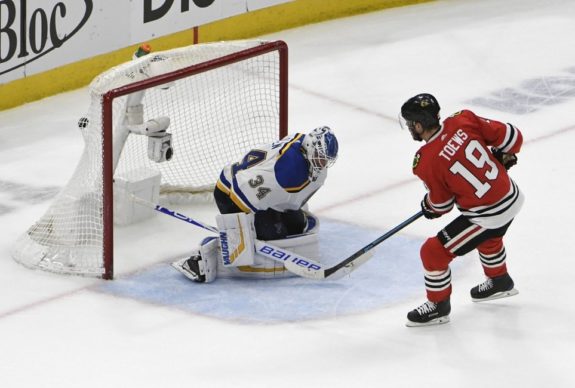
Toews’ leadership skills are unquestioned and his resume speaks for itself, but as a general manager, you also can’t have your captain indirectly questioning the direction the team is taking in the offseason.
Knowing Toews’ past, most general managers would love to bring a future Hall of Famer like Toews into the fold. That makes him appealing to other teams. Why should it be appealing for Bowman to trade him? When you look deeper into his numbers, the longtime captain is still productive but analyzing his expected goals average over the last decade shows an interesting downward trend.
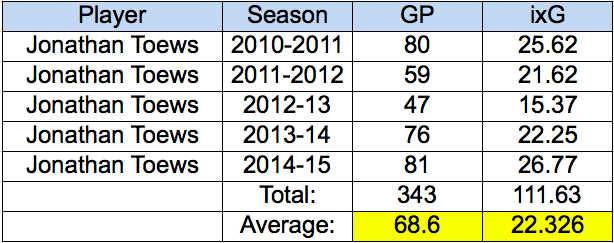
First, we must acknowledge that 2012-13 was the lockout-shortened season and that Toews’ lower expected goals total that season is an outlier. But let’s compare the averages from the first five seasons of this past decade to the past five seasons in the chart below.
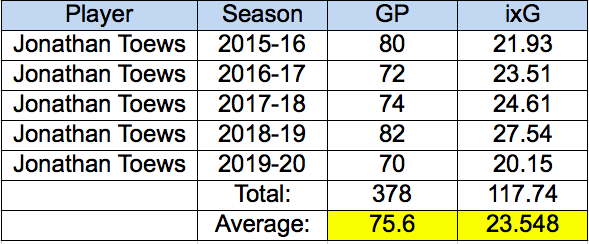
At first glance, one reads that Toews’ expected goals total output was higher over the last five seasons and so was his games played, meaning that he is staying productive and healthy still at 32. But that’s the point. He played in an average of almost seven more games per season, but only had an average of one more expected goal.
Further, Toews is now two seasons removed from putting up a career-high 27.54 expected goals and 35 actual goals during the 2018-19 season (the last full pre-pandemic season). Numbers that inflate that averages over the last five seasons but production that might catch the eye of another general manager.
Need further convincing? Let’s look at Toews’ wins above replacement (WAR) over the same time span to show his decline in on-ice value to the Hawks. Much like in baseball, WAR is a great tool to find out how a player impacts their lineup.
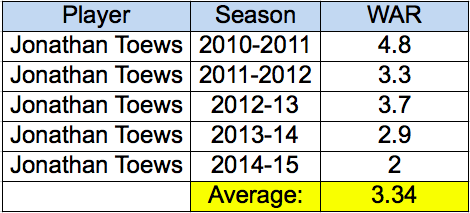
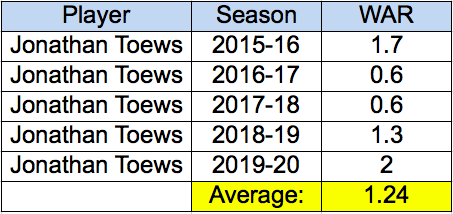
It is clear that over the last five seasons, Toews has been worth about two fewer wins above replacement, and while he was on much better teams during those first five seasons of the past decade (two of which won Stanley Cups), that also means there were better replacements.
And it’s not just in WAR that Toews has seen a downturn, his Standing Points Above Replacement (SPAR) have seen a dip, with the long-time captain failing to hit five SPAR in any of the last five seasons, including a career-worst 1.1 SPAR during the 2017-18 season and a not much better 1.2 the year before in 2016-17. Additionally, his shooting percentage has dropped, falling to a career-low 9.5% in 2017-18 and 10.5% this past season. In comparison, Toews never had a shooting percentage below 12% in his first nine seasons in the league.
There is still plenty to like about Toews from a rival GM’s perspective, including the fact that he is still very effective in the faceoff circle, with his success rate still registering at above 56 percent in each of the last three seasons, as well as his championship and leadership pedigree as noted earlier. But when you factor in his age at 32 and salary cap hit, an estimated $10.5 million AAV over the next three seasons according to THW’s salary page, if you can convince Toews to waive his no-movement clause, one would have to expect a nice return of high draft picks and prospect capital for the future Hall of Famer.
Speaking of salary caps…
Cap Space
At this point in the offseason, the Blackhawks have $5.2 million in cap space, with Dylan Strome still lurking as a restricted free agent and needing a new deal (more on that below). But if Bowman were to trade Toews as per our suggestion above and others, that could create cap space into the seven figures.
Despite the struggles of the current economy, the Blackhawks should not try to save their organization money, but instead use the current climate to take advantage of other teams. With a flat cap, teams might need to unload bad contracts or players who need to go on long-term injured reserve (LTIR). Thus, cap space should be something to go in Chicago.
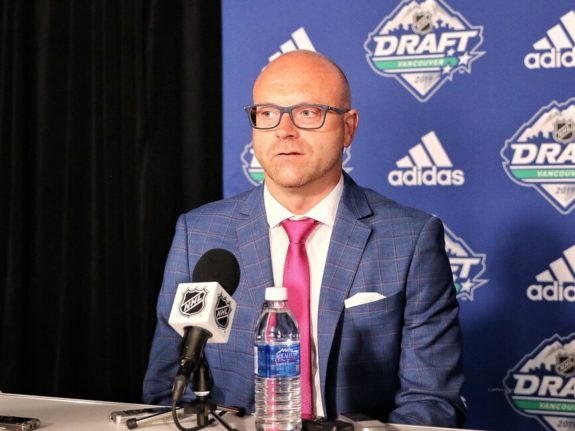
A perfect example of general managers using cap space to improve their prospect capital can obviously be found with the Vegas Golden Knights, who piled draft picks in exchange for bad contracts in the expansion draft. But some existing teams who have pulled this off recently are the Montreal Canadiens and the New Jersey Devils.
In the summer of 2018, the Canadiens acquired goalie Steve Mason, whom they bought out to the tune of a $2.7 million cap hit over the next two seasons, in addition to Joel Armia, a seventh-round pick in 2019, and a fourth-round pick in 2020 from the Winnipeg Jets. While it remains to be seen how those draft picks pan out, Armia has since gone on to become an effective bottom-six winger over the last two seasons with the Habs, registering almost 17 expected goals last season and a WAR of 1.1. All that Montreal general manager Marc Bergevin had to give up in the deal? Cap space and defenseman Simon Bourque, who is set to play in France next season.
Another example of a classic salary dump came in the summer of 2016, when the Florida Panthers acquired the LTIR contract of Marc Savard and a second-round selection in the 2018 draft in exchange for two depth forwards, neither of whom have played in the NHL since.
What did Devils general manager Ray Shero do with that second-round pick in exchange for taking on Savard’s cap hit? He traded that pick (in addition to a third-round pick) to the Washington Capitals in exchange for Marcus Johansson, who was coming off an impressive 24-goal campaign with a 3.7 WAR season with the Caps. Johansson suffered injuries in his time with New Jersey but was dealt the next season to the Boston Bruins in exchange for a second-round pick in 2019 and a fourth-round pick in 2020, building more potential prospect capital.
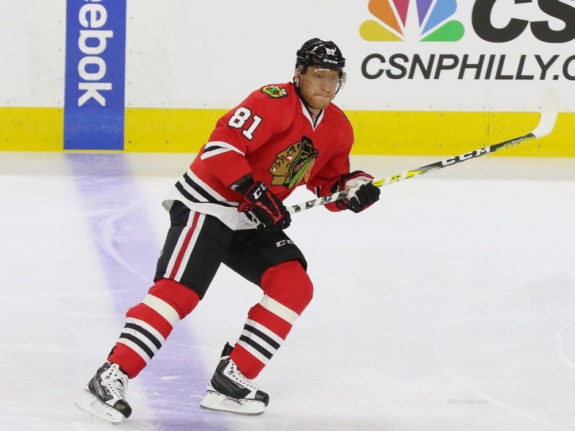
Stan Bowman and the Blackhawks of course have some previous experience with salary dump trades, dealing Marian Hossa and his $5.25 million cap hit, along with Vinnie Hinostroza and Jordan Oesterle, as well as third and fifth-round draft picks to the Arizona Coyotes in a seven-player deal that saw the Hawks acquire Marcus Krueger and Jordan Maletta, defenseman Andrew Campbell, the rights to then-unsigned draft pick MacKenzie Entwistle, and a fifth-round pick in the 2019 draft.
A trade that doesn’t blow the socks off for either fan base but one in which the Coyotes acquired a solid depth forward in Hinostroza in addition to two draft picks, while the Hawks also got Entwistle who projects to be a depth forward with size and a good hockey IQ for Chicago.
If Bowman can maximize the returns from these cap dumps, then there is potential to add prospects or draft picks that can turn into prospects with good scouting and player development in exchange for easing another team’s salary cap burden.
Keith and Shaw (Maybe Seabrook)
Speaking of modified salary dumps like Hossa, while players like Duncan Keith, Brent Seabrook, and Andrew Shaw all provide leadership, which is important in a young locker room, the analytics state that they are not helping the team win on the ice and should also be ones to go in the Blackhawks’ rebuild.
A salary dump like Mason and Savard is obviously not recommended as that does not help the Blackhawks in the long term and they don’t need to deal these players for cap relief but instead for draft picks or prospect capital. So a deal sending out Seabrook, who missed the last two and a half months of the season after undergoing double hip surgery and shoulder surgery might have to include picks and prospects. If this is the case, put his salary cap hit onto LTIR-retirement. If he’s capable of playing for a team who will take him on for the Hawks to retain some salary in exchange for picks and prospects, then it is worth looking into.
While the Blackhawks may have to retain some salary in dealing any of these three players, that is a consequence that would be worthwhile as it would increase the talent and projection level of a prospect or a pick.
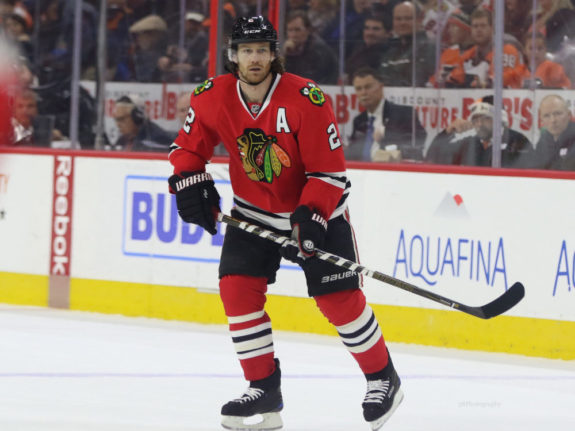
Much like Toews, both Keith and Seabrook have impressive resumes and will no doubt be recognized on lists of best Blackhawks defensemen in history for years to come, but their effectiveness in Chicago has ended.
Last season, the Blackhawks ranked sixth in the league in expected goals for per 60 minutes (xGF/60) with 2.5, according to Evolving-Hockey. However, the team ranked dead last in expected goals against per 60 minutes (xGA/60) with 2.78 expected goals against per game.
Goaltending is certainly one factor in that equation but defense is another, and the two leaders of that blue line unit in Keith and Seabrook have not put up positive advanced numbers defensively for the last few seasons.
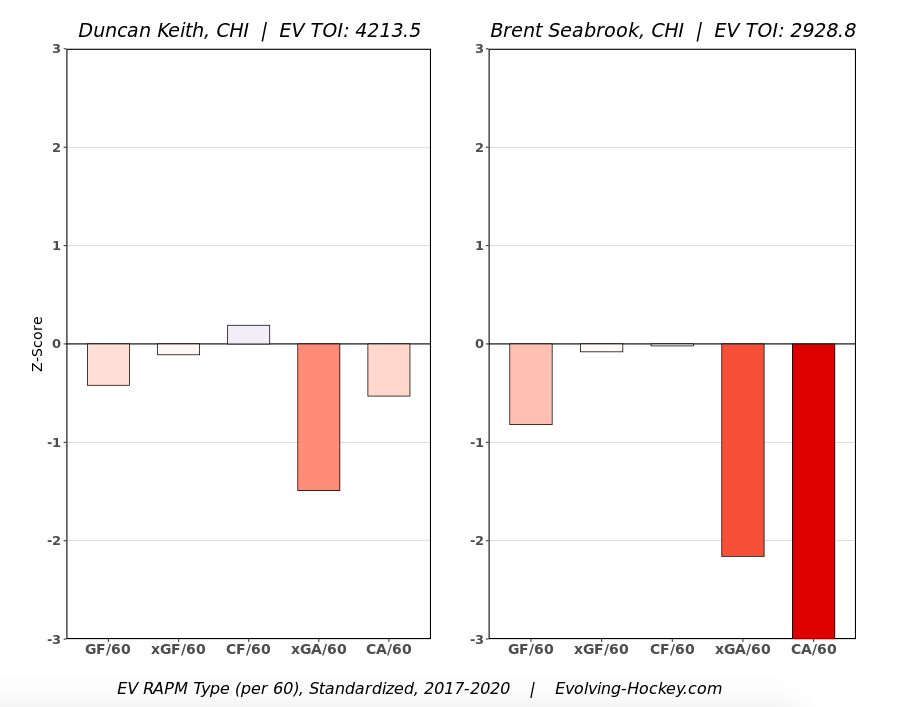
The above even-strength regularized adjust plus-minus (EV RAPM) chart factors in goals for (GF), expected goals for (xGF), Corsi for (CF), expected goals against (xGA) and Corsi against (CA) per 60 minutes, which can show “how a player has performed relative to all other players at the same position over the selected timeframe”, according to Evolving-Hockey.com.
In the above chart, which tracks Keith and Seabrook over the course of the last three seasons, both players have negative scores defensively in comparison to other defensemen, but also negative or mediocre offensive advanced metrics at even strength. The offensive numbers get better on the power play, and it is that experience and success on the man advantage that might make Keith, and most definitely to a lesser extent Seabrook, an attractive option for a team looking for help on the power play.
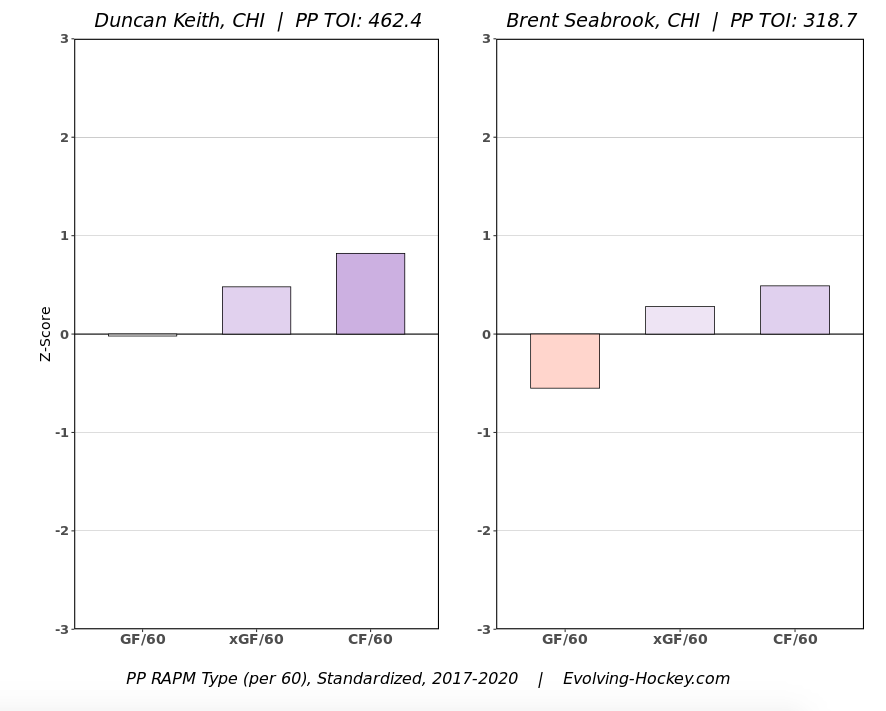
At age 37 and with a cap hit of $5.5 million over the next three seasons for Keith, and Seabrook at age 35 and with a $6.875 million cap hit over the next four seasons, it would be worthwhile to see what the returns are if both players are healthy and willing to waive their no-movement clauses to acquire prospect capital or draft picks which can be used to acquire help on defense, as well as make room for young defensemen like Nicolas Beaudin, Adam Boqvist, and Alec Regula, in addition to the incoming steady defensive duo of Nikita Zadorov and Anton Lindholm, both of whom have put up okay defensive metrics at even strength for the Colorado Avalanche before being dealt to Chicago in the Saad trade.
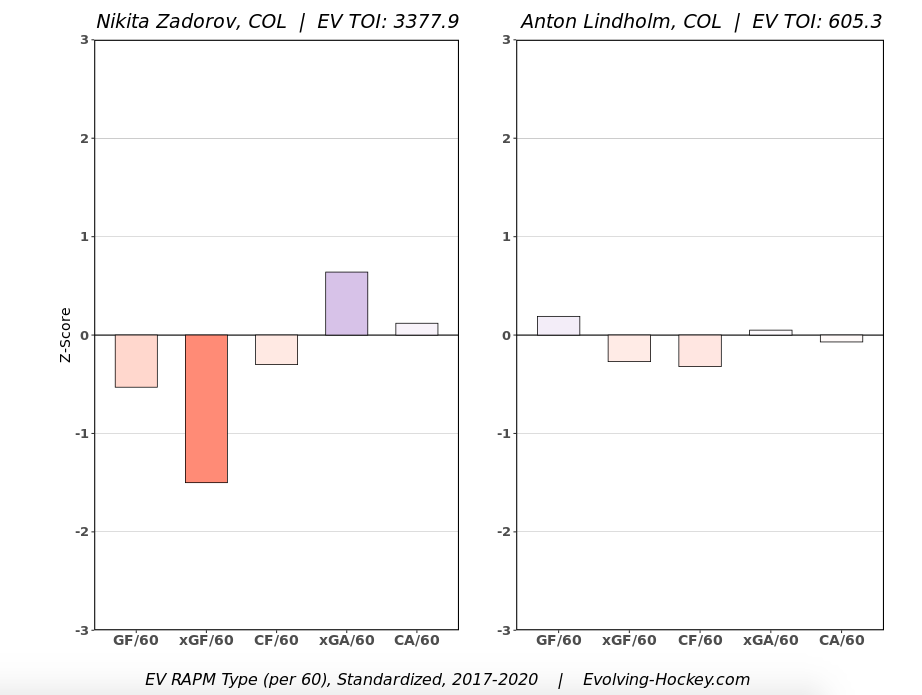
Also included in this group of older players who have been a defensive liability to the Blackhawks is Andrew Shaw. Set to turn 30 at the end of next season and with a cap hit of $3.9 million over the next two seasons, Shaw’s game is not one that translates well with age. And with the Hawks preferring to go with youth in their rebuild, moving on from Shaw might be wise and possible as contenders are always looking for grit, which comes in handy especially in the post-season.
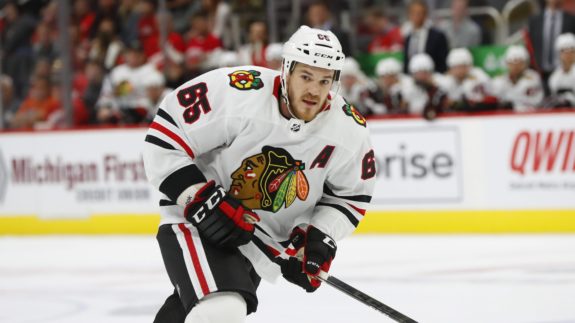
Shaw’s first season back in Chicago in 2019-20 was a forgettable one, playing in just 26 games and registering ten points while posting positive advanced metrics in expected goals for per 60 minutes and Corsi For per 60 however. As noted above, Chicago struggled on the defensive end of the puck, and while Shaw provides toughness and is a two-way forward, his advanced defensive metrics were negatives for the Hawks in 2019-20.
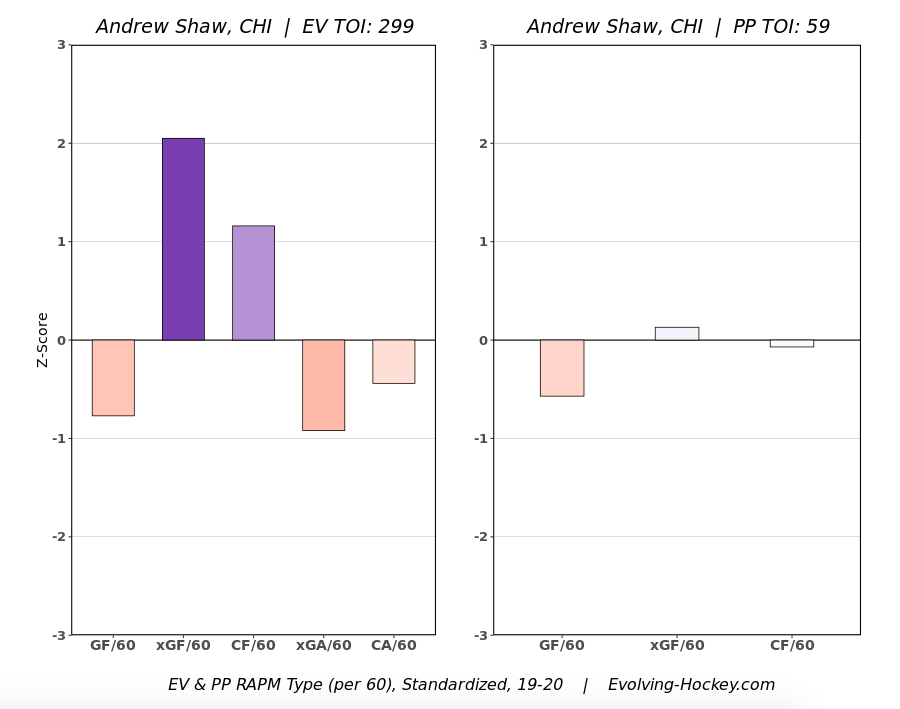
Considering that Chicago gave up a second and seventh-round pick in the recent 2020 NHL Draft, in addition to a third-round pick in next year’s draft to acquire Shaw from the Habs in the offseason, it would be wise for Stan Bowman to try and recoup some draft picks for his rebuild.
Dylan Strome
It might seem questionable to move on from a young player like Dylan Strome in the midst of a rebuild, but the analytics show a flawed player whose return could help speed along the rebuilding process.
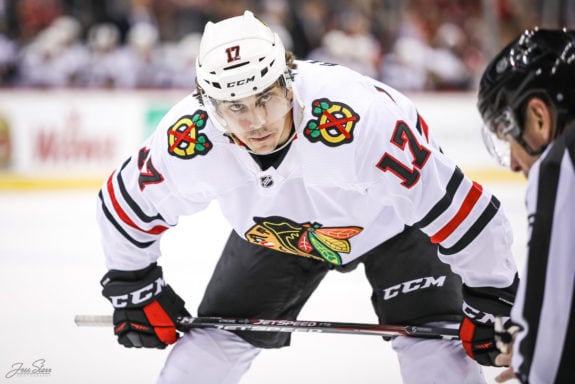
Since arriving in Chicago, Strome has been a good presence offensively, putting up decent advanced offensive numbers in expected goals and WAR, with the latter category slipping this past season.

At just 23-years old and still a restricted free agent, Evolving-Hockey.com projects Strome’s next contract to be a bridge deal at two-years and worth an AAV of $3.371 million. But with young forwards in Alex Nylander, David Kampf, and Lucas Wallmark set to become RFA’s next season and Dominik Kubalik set to hit the same status the year after, it would be wise to clear salary room for them and use Strome to build prospect and draft pick capital.
An opposing GM should be willing to give a nice return from a still young and promising center in Strome. One who has registered a 52.1% face-off winning percentage in the offensive zone over the last two seasons, while also registering an impressive 59.8 percent winning percentage on power-play draws over the same time span.
The appeal to the Blackhawks in moving on from Strome? Dealing away a player who posts good advanced numbers offensively but not at the level of a Kane, DeBrincat, or Kubalik, but who has struggled with advanced defensive metrics in his time with Chicago while also winning just 45.1 percent of his defensive zone draws.
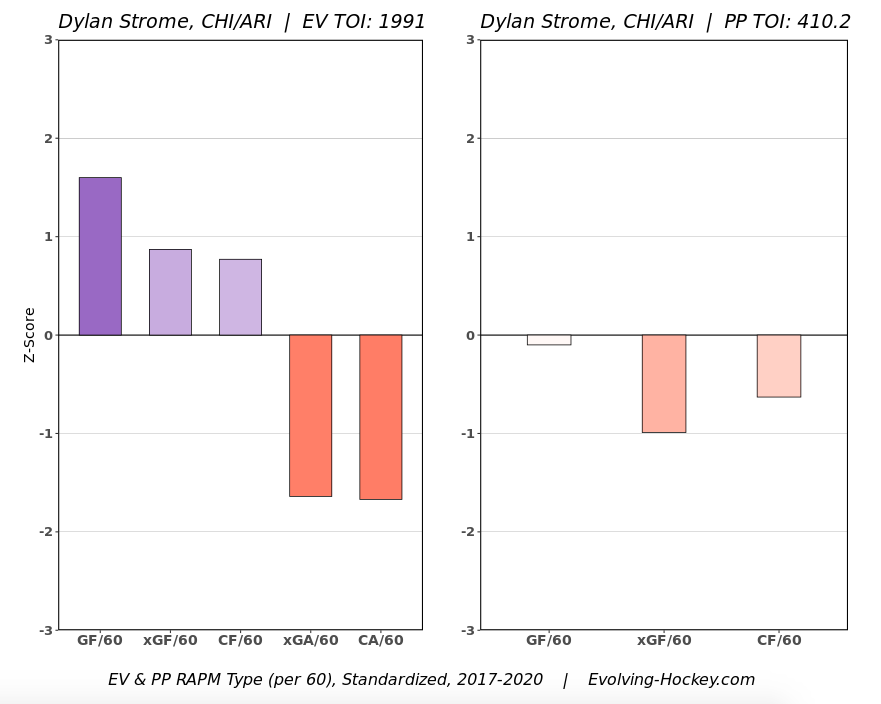
Who Should Stay
Patrick Kane
Players like Kane come around once every generation, and despite getting set to turn 32 next month, the skilled winger and former Hart Trophy winner is showing no signs of slowing down. That is why of the Core Four players, he should be the one to stay and help the rebuild along.
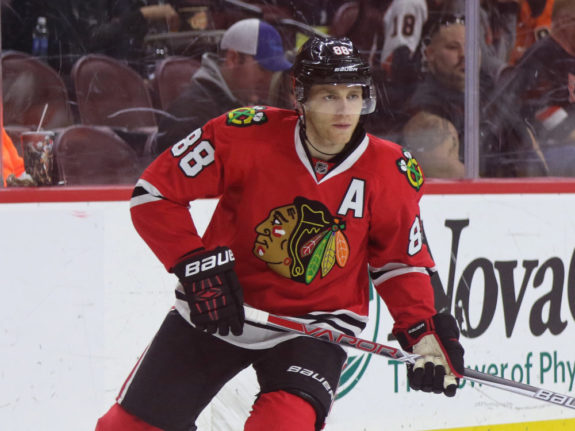
Kane, a native of Buffalo, NY, is just two seasons removed from putting up career-best point totals with 44 goals and 110 points during the 2018-19 season. This past season, Kane registered a team-best 33 goals and 84 points in 70 games, roughly putting him on pace for close to another 100-point season.
The three-time Stanley Cup champion also lead his team in most of the advanced stat categories this season with the most individual expected goals for (25.28), individual Corsi for (464), individual scoring chances for (265), rush attempts (15), and rebounds created (24), according to data taken from both Evolving-Hockey and Natural Stat Trick.
League-wide, Kane ranked 14th in individual expected goals as well, while his Corsi for ranked eighth, just one spot behind Auston Matthews. Meanwhile, he finished seventh in scoring chances for, one spot ahead of Hart Trophy winner Leon Draisaitl, and finished tied for fifth in rush attempts at even strength according to Natural Stat Trick’s data set.
Kane was effective at even strength but also contributed on a man advantage that ranked 28th and didn’t have many positives to talk about, leading the team in power-play assists (15) and points (23), as well as in individual expected power-play goals with 7.61 on the year.
While we have talked about Chicago’s defensive struggles, and Kane has certainly been a factor in that as can be seen in the RAPM chart below, his offense and experience would be hard to duplicate or replace through trades or drafting, while also being a welcome complement to the offensive upside of the team’s young group of talented forwards.
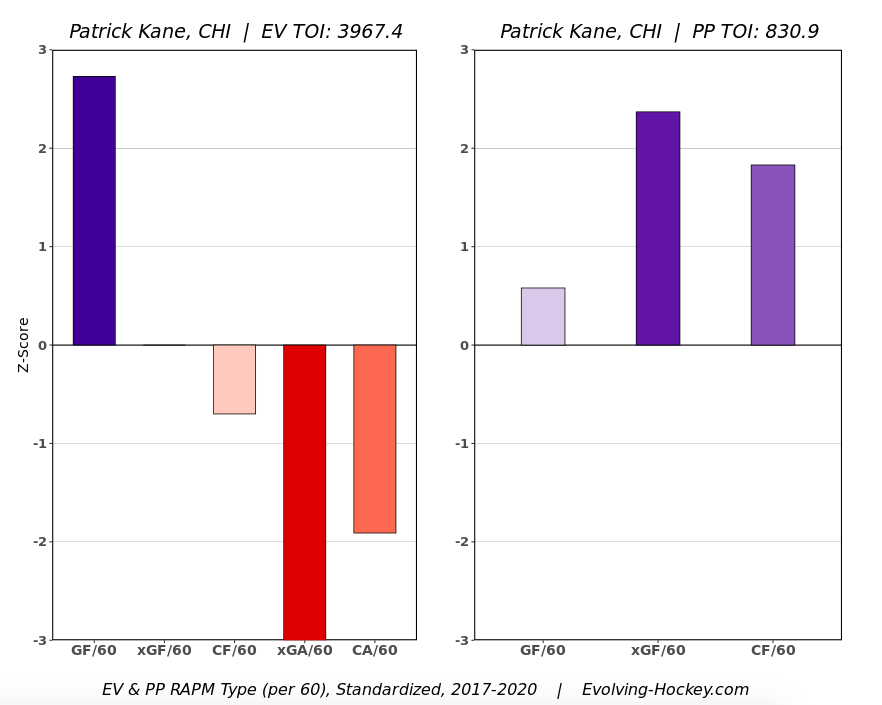
The Talented Trio – Kubalik, DeBrincat, Dach
The Blackhawks have been lead offensively by the dynamic duo of Toews and Kane for over a decade but there is a new crop coming after them, one that was instrumental to the success that Chicago did have in this shortened season that led to their first playoff berth in three seasons.
Much like the rebuild of the Toronto Maple Leafs, the Blackhawks have a terrific young trio of forwards including Kirby Dach, Alex DeBrincat, and Calder Trophy finalist Dominik Kubalik, certainly a factor in why the club finished in the top ten in expected goals this past season and was the youngest team to qualify for the expanded playoffs. Add to that list the incoming European free agent Pius Suter, who led the Swiss National League in points last season, and this will be a fun group to watch.
The trio of Dach, Debrincat, and Kubalik present some similarities to the trio of Auston Matthews, Mitch Marner, and William Nylander. While none of the Hawks’ young players are as dynamic as Matthews, there were very similar advanced offensive metrics between Marner and Nylander and Chicago’s young stars in their rookie years
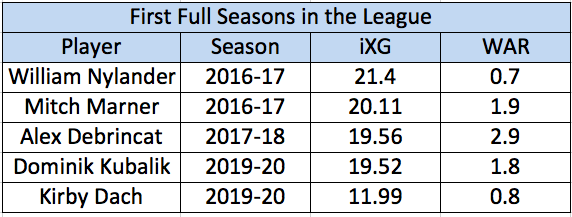
The key of course for Bowman and Blackhawks management will be to get all three under contract for under seven figures to avoid a cap crunch that the Leafs now find themselves in each offseason.

The trio of Dach, DeBrincat, and Kubalik were key drivers in Chicago’s offense, with both DeBrincat and Kubalik registering 21.25 and 19.52 expected goals respectively. DeBrincat also ranked second on the team in scoring chances for with 215, behind Patrick Kane’s 265, according to Natural Stat Trick. Kubalik ranked fifth in this stat category with 163 scoring chances, while Dach ranked seventh with 98 of them.
DeBrincat and Kubalik were also leaders on an albeit anemic man advantage, as the former lead the team with ten power-play goals while the latter ranked third with four of them.
The future is bright with the aforementioned forward prospects as well as the young defensemen already listed in right-handed rear guards Boqvist and Regula. Adding in promising defensive college prospect and right-handed shot Ian Mitchell along with goaltender Collin Delia, the Blackhawks have a terrific young core to rebuild around, the key will be to help shore up the defensive side of the team’s play and goaltending to build depth to surround these players with.
Head Coach Jeremy Colliton
While we have spent the majority of this article showing why the Blackhawks should rebuild around their youth, hanging on to a young coach who is more in touch with his younger players and has been there since the early stages of most of their NHL careers are why Chicago should keep 35-year old head coach Jeremy Colliton.
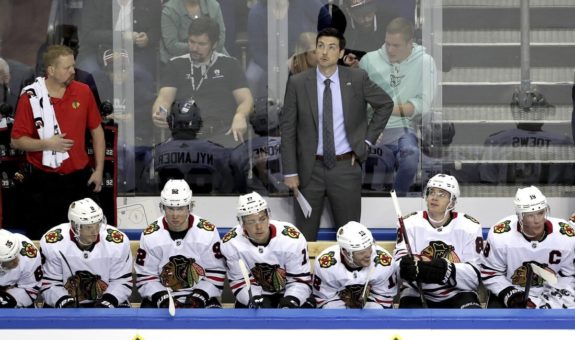
The youngest head coach in the league, Colliton certainly has areas to work on as mentioned, such as the team’s defensive metrics and their anemic power play. The positives have also been pointed out however as the team finished top ten in expected goals, ranked ninth with an 82.1 percent penalty kill, and he was of course was behind the bench of the youngest team to qualify for the expanded playoff format.
There is some indication that the team is on the upswing as well since Colliton took over as head coach on November 6, 2018. During that time span, Colliton ranks tied for 12th amongst head coaches in regular-season wins with 62, while also ranking sixth among bench bosses in team goals for (429) and fifth in team scoring chances for according to Natural Stat Trick.
With one season left on his contract, the Blackhawks should keep Colliton around for the rebuild, which it seems like is in the plans as Bowman said in an interview that he will “most likely” extend his young coach.
Summary
Whether Stan Bowman and the Blackhawks can pull off a successful rebuild is not an answer that we will have for many years. And there are several different definitions of success as well, with the ultimate being capturing a Stanley Cup.
There are lots of moving pieces to a rebuild and analytics are not the only factor. There are contracts, no trade and movement clauses, as well as off-ice metrics such as leadership and chemistry to account for.
Related: Flyers – Revisiting the Hartnell and Timonen Trade
Additionally, it is easy to say that a GM should trade a player, but the returns must be maximized. And that is something that this franchise has struggled with in recent years, with underwhelming returns in trades that sent out prime assets such as Brandon Saad, Artemi Panarin, Teuvo Teravainen, Nick Leddy, and Dustin Byfuglien.
But with a superstar in Kane, the talented young players in the fold who are already putting up positive advanced offensive metrics, promising young prospects on the way, combined with smart trading, drafting, and prospect development, through who should stay and go based on the data provided in this analysis, this is a team that could be poised to be an annual Cup contender.